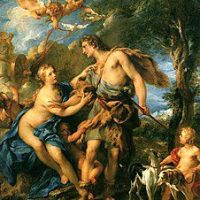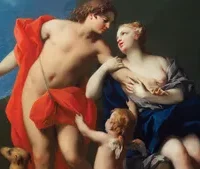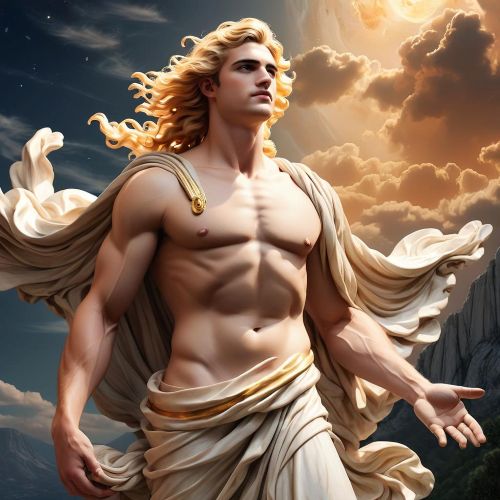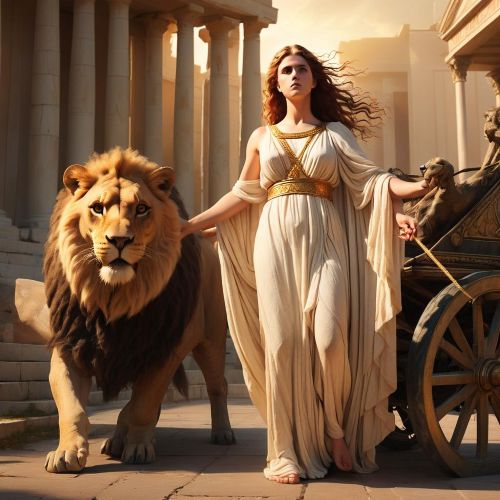Adonis : The Icon of Irresistible Masculine Beauty
Listen
At a glance
| Description | |
|---|---|
| Origin | Greek Mythology |
| Classification | Mortals |
| Family Members | Myrahh (Mother), Cinyras (Father) |
| Region | Greece |
| Associated With | Beauty |
Adonis
Introduction
Adonis, a captivating figure in Greek mythology, embodies beauty and desire in a tale that spans generations. His story, rich with themes of love, mortality, and the cyclical nature of existence, resonates deeply across cultures. Not a traditional Olympian deity, Adonis occupies a distinct place in the Greek pantheon, symbolizing the ephemeral nature of youth and the potency of love. Throughout history, his narrative has been recounted countless times, serving as a poignant reminder of the transient quality of beauty and the perpetual cycle of life and death.
Physical Traits
Adonis’s beauty is legendary, hailed as the pinnacle of masculine grace and allure in ancient texts. Portrayed as a young man of unparalleled charm, his radiant features captivate both mortals and immortals alike. Descriptions abound of his golden locks flowing like sunlight, his skin akin to flawless marble, and his eyes reflecting the celestial depths. Adonis embodies the epitome of physical perfection, a beacon of aesthetic harmony that enchants all who lay eyes upon him. His breathtaking allure transcends mortal comparison, drawing the admiration of goddesses such as Aphrodite, the embodiment of love and beauty, and Persephone, the queen of the underworld.
Family
Adonis’s lineage is steeped in intrigue, with conflicting accounts weaving tales of his parentage. Some sources claim him as the son of Cinyras, king of Cyprus, and his daughter Myrrha, while others attribute his birth directly to the goddess Aphrodite herself. Despite these variations, Adonis’s association with Aphrodite remains a constant, as she was enthralled by his unmatched beauty. Their passionate yet tragic relationship forms a cornerstone of Adonis’s mythos.
One prevailing narrative recounts the extraordinary circumstances of Adonis’s birth. Myrrha, pursued by the relentless advances of the god Theias, beseeched the gods for refuge and was transformed into a myrrh tree. From this enchanted tree, Adonis emerged, a radiant babe captivating even the goddess Aphrodite with his allure.
Though versions of the tale may differ, the essence remains unchanged: Adonis’s origin intertwined with the myrrh tree, symbolizing the fragility and beauty of life itself. Whether born of mortal or divine lineage, Adonis’s story is forever entwined with the mysteries of his birth and the irresistible pull of his beauty.
Other names
Adonis’s name holds a deeper significance beyond its Greek origins. Rooted in earlier Near Eastern myths, particularly those of the Canaanite deity Tammuz, Adonis embodies themes of beauty, fertility, and the cyclical nature of life and death. The Semitic word “adon,” meaning “lord,” likely gave rise to his name, reflecting his divine status. Additionally, Adonis was known by various epithets and alternative names throughout history, such as “Alios” and “Adonai,” further emphasizing his lordly attributes.
In Phoenician mythology, Adonis is equated with Tammuz, a god associated with fertility and vegetation, sharing striking parallels with the Greek narrative. Similarly, in Semitic tradition, he is referred to as Adon, highlighting his divine mastery and significance in religious rites. These alternative appellations underscore the widespread appeal and enduring legacy of the Adonis archetype across diverse civilizations, transcending cultural boundaries to symbolize universal themes of beauty, desire, and the eternal cycle of life.
Powers and Abilities
Though not counted among the traditional Olympian gods, Adonis possessed a charm and beauty that could enchant even the mightiest deities. Despite his allure, Adonis was mortal, and his tale revolves around the cycle of life and death, intertwined with themes of nature and fertility. His association with the changing seasons mirrored his own mortality, with his absence akin to winter and his return symbolizing spring. In certain versions of the myth, Adonis’s blood was believed to nourish the earth, bringing forth flowers in his wake.
While lacking the divine powers of the gods, Adonis was celebrated for his prowess as a hunter, a skill that ultimately led to his tragic demise. His beauty, however, was his most potent attribute, captivating both mortals and immortals alike. Revered as a symbol of fertility and renewal, Adonis was believed to preside over the rejuvenation of nature, particularly the blooming of flowers and the revitalization of the earth.
Central to Adonis’s story is his tumultuous love affair with Aphrodite, the goddess of love. Upon discovering the infant Adonis, Aphrodite was entranced by his beauty and took him under her wing. However, a rivalry erupted between Aphrodite and Persephone, the queen of the underworld, over Adonis’s affections. Zeus intervened, decreeing that Adonis would split his time between the two goddesses and a third of his own choosing.
Tragically, Adonis’s fate was sealed by the jealousy of Ares, Aphrodite’s paramour. Disguised as a boar, Ares fatally wounded Adonis during a hunt. Aphrodite, devastated by his death, wept tears that mingled with his blood, causing crimson anemones to bloom from the earth. Thus, Adonis’s tale endures as a poignant reminder of the fragility of life, the power of love, and the eternal cycle of nature.
Modern Day Influence
The ancient Greeks found profound resonance in the myth of Adonis, seeing in his story a reflection of the cyclical rhythms of the natural world, where death gives way to rebirth. Across Greece and beyond, cultic rituals marked Adonis’s passing in the fall and rejoiced at his return in the spring. These ceremonies often involved planting seeds in pots, symbolizing both life’s fleeting beauty and the promise of regeneration.
Adonis’s influence transcends ancient myth, permeating modern culture with his association with exceptional beauty, particularly in men. Artists, writers, and poets have drawn inspiration from his story for millennia, reimagining and celebrating his image through various mediums. From the masterpieces of ancient Greek sculpture to Renaissance paintings and contemporary plays, Adonis’s allure continues to captivate.
In modern times, the myth of Adonis maintains its significance, with his name becoming synonymous with physical attractiveness. His story has been immortalized in literature, art, and popular culture, serving as a timeless symbol of beauty, desire, and the fleeting nature of life. Authors continue to draw upon the Adonis archetype, exploring themes of love, longing, and mortality. Artists, too, continue to depict Adonis in various forms, preserving his ethereal beauty for future generations.
Moreover, Adonis’s influence extends beyond mere aesthetics, permeating contemporary language and thought. The term “Adonis” is commonly used to describe individuals of exceptional physical allure, underscoring the enduring relevance of his mythological persona. Furthermore, Adonis serves as a potent symbol in discussions of gender, sexuality, and identity, challenging conventional notions of beauty and masculinity with his timeless allure and tragic fate.
Related Images
Sources
Burkert, W. (1985). Greek religion: Archaic and classical. Blackwell Publishing.
Encyclopaedia Britannica. (n.d.). Adonis. In Britannica.com. Retrieved November 19, 2025, from https://www.britannica.com/topic/Adonis-Greek-mythology
Frazer, J. G. (1922). The golden bough. Macmillan.
Graves, R. (1992). The Greek myths. Penguin Books.
Kerenyi, K. (1959). The heroes of the Greeks. Thames and Hudson.
Theoi Project. (n.d.). Adonis. In Theoi Greek mythology. Retrieved November 19, 2025, from https://www.theoi.com/Ouranios/Adonis.html
World History Encyclopedia. (n.d.). Adonis. In Worldhistory.org. Retrieved November 19, 2025, from https://www.worldhistory.org/Adonis/
World History Encyclopedia. (n.d.). Tammuz. In Worldhistory.org. Retrieved November 19, 2025, from https://www.worldhistory.org/Tammuz/
Frequently Asked Questions
Who is Adonis in Greek mythology?
Adonis is a legendary figure celebrated for his extraordinary masculine beauty. Loved by Aphrodite and desired by Persephone, he became a powerful mythic symbol of love, desire, and life’s fragility. His story represents passion and the fleeting nature of youth.
Why is Adonis connected to rebirth and nature cycles?
After his tragic death, Adonis was allowed to return from the underworld for part of each year. This seasonal cycle mirrors nature’s own rhythm — his presence symbolizes spring and life returning, while his absence reflects the dormancy of winter.
How was Adonis born?
According to myth, Adonis was born from the myrrh tree that his mother Myrrha transformed into after a cursed and tragic relationship with her father. This miraculous birth links Adonis directly to themes of transformation and the beauty emerging from suffering.
What caused Adonis’s death?
During a hunt, Adonis was fatally attacked by a wild boar. Many versions suggest the boar was actually Ares, driven by jealousy over Aphrodite’s love for Adonis. His death became a powerful reminder of how beauty and love can provoke dangerous envy.
Why does “Adonis” mean a very attractive man today?
His myth created a lasting cultural standard for perfect male beauty. Over centuries, writers and artists used Adonis as the model of physical allure. Today, calling someone “an Adonis” implies not just handsomeness, but a charismatic and irresistible presence.













